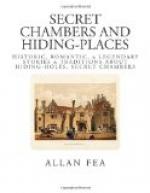The hiding-place is located beneath the floor of a cupboard, adjoining the quaint old panelled bedroom the King occupied while he was at Moseley. Even “the merry monarch” must have felt depressed in such a dismal hole as this, and we can picture his anxious expression, as he sat upon the rude seat of brick which occupies one end of it, awaiting the result of the sudden alarm. The cupboard orginally was screened with wainscoting, a panel of which could be opened and closed by a spring. Family tradition also says there was a outlet from the hiding-place in a brew-house chimney. Situated in a gable end of the building, near the old chapel, in a garret, there is another “priest’s hole” large enough only to admit of a person lying down full length.
Before the old seat of the Whitgreaves was restored some fifteen or twenty years ago it was one of the most picturesque half-timber houses, not only in Staffordshire, but in England. It had remained practically untouched since the day above alluded to (September 9th, 1651).
Before reaching Trent, in Somersetshire, the much sought-for king had many hardships to undergo and many strange experiences. We must, however, confine our remarks to those of the old buildings which offered him an asylum that could boast a hiding-place.
Trent House was one of these. The very fact that it originally belonged to the recusant Gerard family is sufficient evidence. From the Gerards it passed by marriage to the Wyndhams, who were in residence in the year we speak of. That his Majesty spent much of his time in the actual hiding-place at Trent is very doubtful. Altogether he was safely housed here for over a fortnight, and during that time doubtless occasional alarms drove him, as at Moseley, into his sanctuary; but a secluded room was set apart for his use, where he had ample space to move about, and from which he could reach his hiding-place at a moment’s notice. The black oak panelling and beams of this cosy apartment, with its deep window recesses, readily carries the mind back to the time when its royal inmate wiled away the weary hours by cooking his meals and amusing himself as best he could—indeed a hardship for one, such as he, so fond of outdoor exercise.
Close to the fireplace are two small, square secret panels, at one time used for the secretion of sacred books or vessels, valuables or compromising deeds, but pointed out to visitors as a kind of buttery hatch through which Charles II. received his food. The King by day, also according to local tradition, is said to have kept up communication with his friends in the house by means of a string suspended in the kitchen chimney. That apartment is immediately beneath, and has a fireplace of huge dimensions. An old Tudor doorway leading into this part of the house is said to have been screened from observation by a load of hay.




